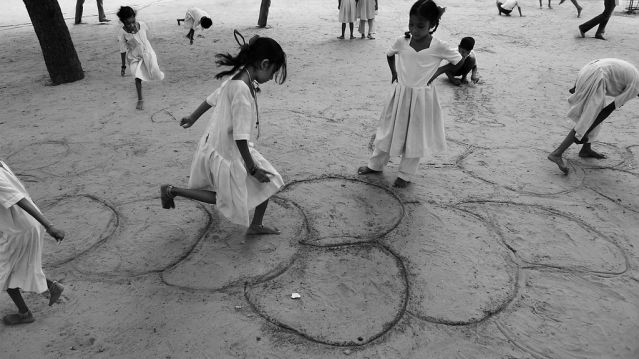
Education
Learning to Move, Moving to Learn?
What is the relationship between physical activity and educational success?
Posted June 15, 2014

Just playing?
A fascinating, and potentially very important experiment was carried in with a group of 10 and 11 year children in Vanves, a small district of Paris, France in the 1950s. The teacher-researchers wondered what would happen if a significant proportion of time for academic subjects during the school day was given over to physical activities. The precise rationale for this bold idea is unclear, but it seems that the researchers simply had a hunch that their students would benefit from daily dose of exercise.
It is unlikely that a study like this would be allowed today. At the least, the researchers would need to spend a great deal of time and energy persuading various committees of the wisdom of drastically cutting 15 hours a week of classroom lessons - math, french, history and so on - and replace it with sports, gymnastics, swimming and hiking. They would also need to secure the agreement of the the parents and children (although I suspect the latter group would not take much persuading), and they would need to address the thorny fact that no one had ever carried out a study like this before, so they had absolutely no idea what would happen. But these were simpler times, when those with potentially risky-but-interesting ideas for experiments tended to just go ahead and do them. So every school day, morning and afternoon, half the children walked, ran, stretched and played, whilst a (presumably fairly miserable) control group continued to take part in the standard two hours a week of physical activities.
The results of the Vanves study were remarkable. Despite the loss of more than a quarter of their classroom teaching time, the academic grades of the experimental group did not worsen, and in many cases actually improved. What’s more, the teachers reported fewer discipline problems, greater attentiveness in class and less absenteeism.
Before we become carried away with these findings and start substituting mathematics with mountain biking and science for salsa in all schools, a note of caution needs to be sounded. This was a small-scale study, although it did use a control group. What’s more, the researchers did not publish their findings in conventional scientific journals, and we only know about it from some magazines of the day, so it was not exposed to the checks and balances of criticism that are characteristic of good science. And anyway, it is notoriously difficult to unpick the relative value and harm done by the multitude of factors experienced by children and young people as they pass through their schooling. Even if we take the reported findings on face value, it is impossible to say with any certainty that physical activity was the key factor. It might have been the case that the increased activity led to changes in the children’s brains that meant they were better able to deal with the intellectual challenges presented to them. Or perhaps the children simply responded well to spending more time outdoors, or in social or playful settings? Perhaps they just liked the novelty offered to them?
So, as it stands, the Vanves experience is little more than an interesting case study. But if its conclusions turned out to be valid, they would raise profound questions about the standard ways in which schools organise and prioritise their various responsibilities. They also hint to a solution to a problem of enormous contemporary importance. However inactive the children of this French district might have been, it is unlikely that they were as grandchildren were likely to become. France, like almost all developed and many developing countries, has witnessed a progressive decline in the levels of day-to-day physical activity among its young people, and this has raised serious concerns about the effects this may have on their health and well-being, both during childhood and in later life. In the words of a recent statement from a group of international health experts published by the Lancet medical journal, young people are currently in the midst of a worldwide ‘pandemic’ of inactivity. So alongside the educational story of the Vanves experiment, there is a second about children’s health which should not be forgotten.
A number of scientists have subsequently returned to the same basic question asked at Vanves - what happens if we cut a large chunk out of the school academic timetable and replace it with physical activity? - and they have generally used more rigorous methods and much larger groups of children. The first of these studies was conducted in the Canadian city of Trois-Rivières in the 1970s, which focused again on Elementary-aged students, but this time tracked more than 500 of them for 6 years, with control groups being formed from the classes preceding and succeeding classes in the same schools. The experimental classes took an hour a day of physical activity classes, leading to a 14% reduction in time for the other school lessons, while the control classes were taught for the standard 40 minutes of Physical Education per week. According to their teachers’ assessments, the overall educational performance of the daily activity group was significantly better than their less active peers. They also scored higher on a standard intelligence test, and achieved higher grades in mathematics in examinations (although they did less well in English tests).
There have now been many studies exploring the question of the relationship between physical activity during the school day and educational performance - more than 40 by my reckoning, based in the USA, Australia, and across Europe and Asia - and they tend to come to broadly the same conclusions: replacing a sizeable amount of time for classroom-based subjects with physical activities does not harm performance in those subjects, and in some circumstances seems to result in improvements in grades for some children.
A second set of studies approached the matter from a slightly different angle: how does physical fitness affect educational performance? Physical activity and fitness are related, of course, as fitness tends to be greater among the most active. But, from the perspective of the poor researcher, fitness is much more slippery concept, as it is impossible to separate the contribution made to fitness from school-based physical activity in school from that which takes place before and after school, over the weekend, and during vacations. It is also a methodological nightmare to deal with the fact that children’s bodies and brains are constantly in a state of change and development, and older, more physically mature children tend to outperform their younger, smaller peers, anyway.
Despite all of these cautions and concerns, it is still worth noting that numerous studies have found that physically fit children tend to outperform their less fit peers. According to one meta-analysis - essentially an overview of published studies - increased fitness was associated with better grades in mathematical and reading, and IQ scores. That it is these particular measures that seem to be most associated with physical fitness is in itself rather intriguing.as some scientists suggest that they are precisely those areas that would be expected to be affected by improved brain functioning. But that is a story to be considered in detail in another article.
For now, consider a recent study from Australia that found that, in the words of its title, ”Schools With Fitter Children Achieve Better Literacy and Numeracy Results”. The researchers found that both activity levels and fitness scores correlated with children’s scores on government tests, and that an even clearer difference was found between schools. In other words, the schools with fitter children outperformed the others. Why would this be? The most plausible explanation seems to be that physical activity and the development of fitness are elements of schools that tend to have ‘atmospheres’ that are supportive of educational achievement and success.
Educational attainment, such as success in examinations and grades, is enormously highly valued by parents, teachers and policymakers. Comparisons between schools, districts, and countries is now a routine feature in many countries around the world, and administrators at every level are in a permanent state of fear that the results under their control relative to those of their competitors. More importantly, from the perspective of responsibility towards individual children, there is no doubt that educational achievement strongly relates to later career success, especially among the most marginalised groups within society.
The default position among many of these decision-makers has been that classroom-based subject areas like math and reading are of the greatest value, and that is essential that these areas are prioritised within schools. A second assumption is that any interference with student success in these areas must be resisted at all costs. Consequently, many schools have found themselves under pressure to squeeze out non-core subjects like the arts and sports, not because they are unimportant, but simply because they are of a lower priority. These practices have been reinforced by parents who fear the consequences of time away from the most academically prestigious subject areas. So, physical activities, like sports and dance, are often relegated to the positions of enjoyable, but ultimately frivolous recreations that distract from the main business of schooling.
In this context, it is hardly surprising that every study from the last few decades of the state and status of physical activity opportunities - and especially of their manifestations as curriculum physical education and sports - has reported serious cause for concern. Some school systems have little or no place for these physical activity experiences. Others keep a place in the timetable, but their quality is undermined by poorly trained or untrained teaching staff, inadequate facilities, or a common pattern that when time and money is limited, these are among the first subjects to be cut. There are obviously considerable variations between countries and states, and over time, but the evidence is quite clear: quality physical activity experiences in their various forms often become pushed to margins, offered as a trivial escape from the main business of the school, or squeezed out of the school timetable completely.
Schools are the main social settings for the promotion of physical activity in children. In fact they are the only place where all children can learn new skills and have regular opportunities to be physically active. But parents, too, can contribute to this situation. A number of international studies has revealed a tendency to discourage children from participation in sports club as students get older, and especially as they move towards important examinations and transitions, such as to high school and university levels. In many cases, girls are most affected by these changes, and they are the ones who are typically less active already [http://www.icsspe.org/sites/default/files/Girls.pdf].
The reasoning behind these action is entirely understandable. Grades in classroom subjects are powerful determinants of later progression and success, so common sense dictates that the more time spent on studying these subjects is a sound investment. Consequently, time spent running about and playing games is time wasted.
Once again, science suggests that common sense is probably wrong.
These and related issues will be the focus of the blog. It aims to explore the complex and, I think, fascinating relationship between physical activity and the good life. What role, if any, do sports and other physical activities play in education, health and happiness? How does exercise affect the brain and behavior? Why does it matter?
Comments and questions are very welcome.
Bailey, R., Hillman, C., Arent, S., & Petitpas, A. (2013). Physical activity: an underestimated investment in human capital?. Journal of Physical Activity & Health, 10(3), pp. 289-308.



